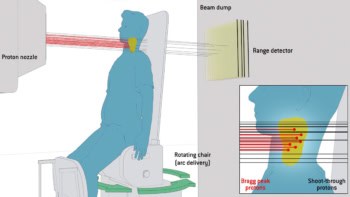
FLASH radiotherapy, the delivery of therapeutic radiation at ultrahigh dose rates, was the subject of several scientific sessions at the 2020 Joint AAPM|COMP Virtual Meeting. One area that particularly caught my eye was the idea of performing FLASH using protons, as described by Jan Schuemann from Massachusetts General Hospital.
The promise of FLASH is that it can vastly reduce normal tissue toxicity while maintaining anti-tumour activity. And while many modalities could potentially be used to translate FLASH into the clinic, “in my opinion, protons are one of the ideal candidates for clinical translation of FLASH radiotherapy,” said Schuemann, noting that several small-animal systems have already been designed to deliver proton FLASH.
The original FLASH irradiator, developed by a team in Lausanne, uses low-energy electrons and has been employed for most FLASH experiments to date, as well as for the first patient treatment. But low-energy electrons have a low penetration depth and are not ideal for clinical translation. Other options include the use of megavoltage photons from a converted linac, the dedicated PHASER system, or an intraoperative radiotherapy set-up.
But the big advantage of using proton FLASH in the clinic lies in the distal layer effect. Proton therapy is typically delivered in layers, starting with the distal layer and building up to cover the entire target. In patients, however, this distal layer typically lies just outside the target in healthy tissue or even within organs-at-risk. “If we just could deliver the distal layer in FLASH mode, we would greatly save important tissue,” Schuemann explained. “This could have a huge impact for how we can deliver treatment plans and bring FLASH into the clinic.”
Clinical proton FLASH could be delivered via double scattering or pencil-beam scanning, both of which would need some technical adjustments. Double scattering, for instance, would use a single modulator wheel rotation to deliver dose to the distal layer instantaneously at FLASH dose rates. Proximal layers, however, may not receive such high dose rates. Schuemann noted that double-scattering systems would need to deliver sufficiently high dose rate across the entire treatment field, which limits the field size but could be a good option for small fields.
Most new proton treatment centres, however, use pencil-beam scanning, which provides a beneficial dose distribution. “The question is, if we have to use scattering systems to achieve FLASH irradiations, is it worth giving up pencil-beam scanning benefits?” he said.
The other option is to use proton scanning for FLASH delivery, as each single pencil beam already delivers a high dose rate. And because FLASH delivery is so fast, the rescanning often used to mitigate motion effects in pencil-beam treatments would no longer be needed. This approach would require additional imaging to ensure the tumour target is correctly positioned.
Schuemann also noted that, while each pencil beam has a very high dose rate, the beam edges contain regions without sufficient dose rate to induce FLASH effect. “So is it better to use scanning beams with high dose rates than what we are currently doing?” he asked.
He also considered which treatment sites are likely candidates for proton FLASH. Any site currently treated with radiosurgery or hypofractionation could be suitable, or sites where normal tissue toxicity currently limits the deliverable dose. “Intraoperative treatments are probably where FLASH radiotherapy will first see clinical daylight,” Schuemann suggested.
The answers to these many questions depend on the underlying mechanisms of FLASH. “Understanding whether it’s a single mechanism or multiple will strongly impact how to plan and deliver FLASH radiotherapy,” Schuemann explained. “We have to know how we can vary the dose rate, how many beams we can use, how timing limitations play a role and whether there’s a limit to the field size we can deliver. Many groups are working on this.”
“I believe there is large potential for FLASH radiotherapy, but there are also many pitfalls, especially if we move too fast,” he concluded. “Most importantly, I believe we should be careful not to rush FLASH into the clinic, because if we don’t understand the mechanisms, we may actually deliver worse treatment and kill off the field of FLASH, which I believe has huge potential benefit.”
Reducing proton FLASH uncertainties
Eric Diffenderfer also discussed the promise of protons for FLASH, telling the meeting attendees about the proton FLASH experiments at the University of Pennsylvania. “Compared with electrons, protons have increased potential for treating deep-seated tumours, with better dose conformality and smaller lateral penumbra,” he said. “And it should be easier to upgrade commercial proton therapy systems, which are typically cyclotron-based, to achieve the very high dose rates required for FLASH.”

As Schuemann pointed out, understanding the underlying mechanisms of FLASH will be key to its clinical deployment. But measuring the biological effects of proton beams is technically difficult, with many variables to consider. One way to improve the reproducibility of radiobiological experiments is to reduce the uncertainty in physical beam parameters. This is the goal of Diffenderfer and his colleagues.
The first task on the route to implementing proton FLASH, Diffenderfer explained, is reducing uncertainty due to beam delivery and positioning. For their experiments, the Penn researchers use a cyclotron-based system in a dedicated proton research room, with a small-animal radiation research platform (SARRP) on rails that slides in and out of the proton beamline. They developed quality assurance systems that confirmed an alignment reproducibility of better than 1 mm between the SAARP and proton beam isocentres.
For FLASH, Diffenderfer explained, it’s important to consider the efficiency of beam transport. Most clinical systems use cyclotrons that produce a fixed beam energy, limiting the extraction efficiency. The major beam loss occurs within the degrader used to select the proton beam energy, with additional loss in the transport system and treatment nozzle. And spreading the beam to increase field size also reduces its intensity.
So to exploit as much of the beam as possible, the team implemented a double-scattering system to efficiently increase the field size. This produced a flat beam profile that can be collimated to a field size of about 2.5 cm across, which the researchers used for their in vivo small-animal FLASH experiments. They also developed a ridge filter that generates a spread-out Bragg peak fast enough to maintain FLASH delivery.
The researchers’ second goal was to reduce uncertainty due to dosimetry at high dose rates. They validated the PTW Advanced Markus chamber that they employed for proton FLASH dosimetry by comparison with a Faraday cup (which is independent of dose rate). Results showed that the ratio of measurements was uniform with dose rate.
Their third aim was to reduce uncertainty due to dose rate variations. The proton beam current from the cyclotron varies slightly over time, which translates to dose rate variation over time. To measure this, Diffenderfer and colleagues used a prompt gamma counter to monitor intra-beam dose rate variations during experiments and correlated these with measured biological effects. “We decided to use a fixed-dose beam control system, as opposed to a fixed-time delivery system, to maintain consistent dose across all experiments,” he noted.
In initial studies using this system, the researchers performed focal proton therapy of mice with pancreatic tumours, treating the animals with either FLASH or standard dose rate protons. Changes in tumour volume after treatment were similar for both modalities, with survival somewhat (but not statistically significantly) increased after FLASH. Intestinal fibrosis – a common limitation in of abdominal radiotherapy – was, however, significantly reduced after FLASH versus standard treatments.
“We have implemented methods to reduce uncertainties and validated the FLASH effect for protons in an in vivo setting,” Diffenderfer concluded.



